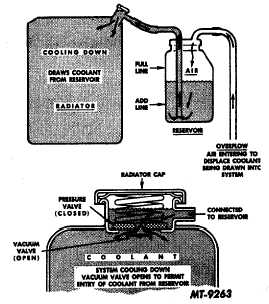|
| |
TRUCK SERVICE MANUAL
TM 5-4210-230-14&P-1
COOLING SYSTEM
Fig. 6 System Cooling Down
For special filling of this type cooling system, refer to
MAINTENANCE Section in this manual.
B. ENGINE WATER JACKET
The water jacket permits coolant to be circulated around
the cylinder walls, combustion chamber and valve assemblies.
Some of the coolant passages are small and can become
clogged if the cooling system does not receive the proper
maintenance.
Close inspection should be given to the following areas:
1.
Core Plugs-These are sometimes mistakenly termed
"freeze plugs". The plugs are present due to engine
block casting methods and not to protect against
expansion from freezing. Core plugs that show signs
of leaking or rusting through should be replaced. Refer
to respective Engine Manual for core plug replacement.
2.
Drain Plugs-The drain plugs located in the water jacket
should receive seasonal care and kept free of rust and
scale.
3.
Gaskets-Must be in good condition to prevent both
internal and external leaks. If there are external leaks
around gaskets, there may also be internal leaks into
the engine. Proper tightening of the head bolts with a
torque wrench is essential for preventing leaks around
the head gasket.
C. WATER PUMP
The water pump circulates the coolant through the
cooling system. It should be checked carefully for leaks and
proper lubrication and if leaking or in bad condition, it should be
rebuilt or replaced promptly. For water pump rebuild, refer to
respective Engine Manual.
D. FAN AND BELTS
The fan should be checked for loose or bent blades. A
loose blade could work free during operation and cause
damage. A bent blade will reduce the fan's efficiency.
Fan belts must be adjusted for proper tension. Refer to
respecting Engine Manual or Operator's Manual for proper belt
tension.
E. THERMOSTAT
Thermostats provide a means of retarding or restricting
the circulation of coolant during engine warm-up. An
inoperative thermostat can cause engine overheating and a
subsequent loss of coolant. Thermostats can be tested by
submerging in hot water and noting the opening and closing
temperature. Use an accurate high temperature thermometer
for making this test. Refer to Engine Manual for proper opening
and closing temperatures.
F. HOSES AND CLAMPS
Hoses and clamps should be checked regularly as they
are often the source of hidden trouble. Hoses may appear in
good condition on the outside but the inside may be partially
deteriorated. If there are any doubts about a hose doing its job,
replacement should be made. Clamps should be inspected to
ensure they are strong enough to hold a tight connection.
G. TRANSMISSION OIL COOLER
On some trucks equipped with automatic or semi-
automatic transmissions, the transmission oil is circulated
through an oil cooler or heat exchanger. The function of this
unit is to control transmission temperature and thereby keep oil
in the proper temperature range for its most efficient lubrication.
This is accomplished by using engine heat to bring
transmission temperature up or by using the cooling system to
dissipate any excessive heat generated within the transmission.
Leakage due to corrosion or an improper seal will cause
contamination between the cooling system and transmission.
CTS-2019P Page 7
PRINTED IN UNITED STATES OF AMERICA
|

